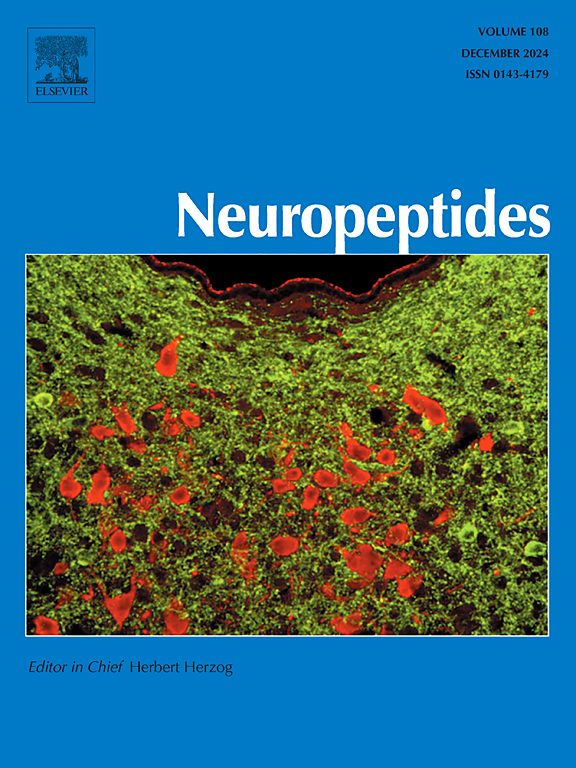P物质以剂量依赖的方式减轻脂多糖诱导的大鼠认知功能障碍
IF 2.7
3区 医学
Q3 ENDOCRINOLOGY & METABOLISM
引用次数: 0
摘要
神经炎症有助于阿尔茨海默病(AD)的认知能力下降,神经激肽途径与AD的病理生理有关。虽然P物质(SP)是神经激肽1受体(NK1R)的内源性配体,主要被认为是一种神经递质,但越来越多的证据表明它具有促炎和抗炎作用。然而,SP-NK1R轴的功能作用的剂量依赖性仍有待充分阐明。在本研究中,我们研究了SP对脂多糖(LPS)诱导的AD大鼠模型的作用。采用脑室内注射150 μg/10 μl LPS诱导大鼠认知功能障碍。SP 50 μg/kg和500 μg/kg 2剂量腹腔注射,每天1次,连用21 d。行为评估包括Morris水迷宫测试和新物体识别测试以调查认知缺陷,开放场测试评估运动。在额叶皮质和海马中检测肿瘤坏死因子-α (TNF-α)、白细胞介素-6 (IL-6)、淀粉样蛋白- β (Aβ)、乙酰胆碱酯酶(AChE)、脂质过氧化和过氧化氢酶。western blot检测全脑cAMP-responsive element-binding (CREB)蛋白水平。LPS治疗显著损害认知能力,增加细胞因子、Aβ、氧化应激和AChE水平,同时降低CREB水平。值得注意的是,低剂量SP (50 μg/kg)可恢复认知能力和AD标志物。而高剂量SP (500 μg/kg)对大鼠空间记忆损伤和神经炎症反应无明显逆转作用。因此,我们的数据表明SP对阿尔茨海默病中神经炎症引起的认知缺陷有剂量依赖性作用。本文章由计算机程序翻译,如有差异,请以英文原文为准。
Substance P mitigates lipopolysaccharide induced cognitive impairment in rats in a dose dependent manner
Neuroinflammation contributes to cognitive decline in Alzheimer's disease (AD), and the neurokinin pathway has been implicated in the pathophysiology of AD. Although Substance P (SP), an endogenous ligand to the neurokinin 1 receptor (NK1R), is primarily known as a neurotransmitter, but emerging evidence indicates it has shown both pro and anti-inflammatory actions. However, the dose-dependent nature of the SP–NK1R axis’s functional role remains to be fully elucidated. In this study, we examined the effects of SP in a rat model of AD induced by lipopolysaccharide (LPS).
A dose of 150 μg/10 μl of LPS was administered through intracerebroventricular injection to induce cognitive impairment in the rats. Two doses of SP, 50 μg/kg and 500 μg/kg were administered intraperitoneally once a day for 21 days. Behavioral assessments included the Morris water maze test and novel object recognition test to investigate cognitive defects, and the open field test evaluated locomotion. Tumor necrosis factor-α (TNF-α), interleukin-6 (IL-6), amyloid-beta (Aβ), acetylcholinesterase (AChE), lipid peroxidation, and catalase were estimated in the frontal cortex and hippocampus. The cAMP-responsive element-binding (CREB) protein levels in the whole brain were estimated by western blot. The LPS treatment significantly impaired cognition, increased levels of cytokines, Aβ, oxidative stress, and AChE, while decreasing CREB levels. Notably, the lower dose of SP (50 μg/kg) restored cognitive performance and markers of AD. In contrast, the higher dose of SP (500 μg/kg) failed to reverse spatial memory impairment and neuroinflammation. Thus, our data propose the dose-dependent effect of SP on neuroinflammation-induced cognitive deficits in AD.
求助全文
通过发布文献求助,成功后即可免费获取论文全文。
去求助
来源期刊

Neuropeptides
医学-内分泌学与代谢
CiteScore
5.40
自引率
6.90%
发文量
55
审稿时长
>12 weeks
期刊介绍:
The aim of Neuropeptides is the rapid publication of original research and review articles, dealing with the structure, distribution, actions and functions of peptides in the central and peripheral nervous systems. The explosion of research activity in this field has led to the identification of numerous naturally occurring endogenous peptides which act as neurotransmitters, neuromodulators, or trophic factors, to mediate nervous system functions. Increasing numbers of non-peptide ligands of neuropeptide receptors have been developed, which act as agonists or antagonists in peptidergic systems.
The journal provides a unique opportunity of integrating the many disciplines involved in all neuropeptide research. The journal publishes articles on all aspects of the neuropeptide field, with particular emphasis on gene regulation of peptide expression, peptide receptor subtypes, transgenic and knockout mice with mutations in genes for neuropeptides and peptide receptors, neuroanatomy, physiology, behaviour, neurotrophic factors, preclinical drug evaluation, clinical studies, and clinical trials.
 求助内容:
求助内容: 应助结果提醒方式:
应助结果提醒方式:


